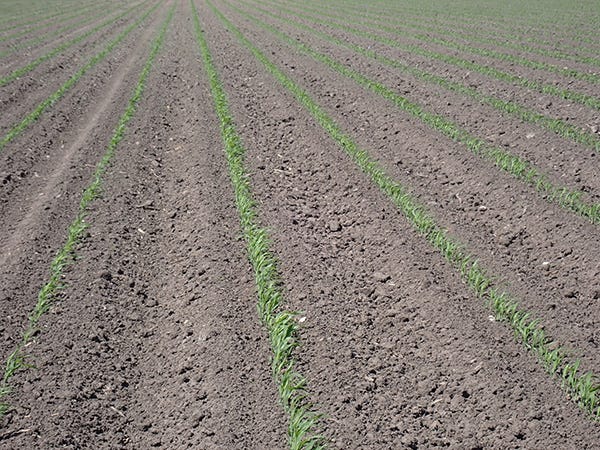
South Texas cotton producers are taking a wait and see attitude as they watch temperatures and soil moisture and finish planting or replanting grain crops.
The mid-February freeze damaged some early-planted crops from the Coastal Bend into the Rio Grande Valley, according to Extension specialists Danielle Sekula, and Josh McGinty and South Texas Cotton, Grain Association Executive Director Jeff Nunley and Webb Wallace, executive director, Cotton and Grain Producers of the Lower Rio Grande Valley.
“A lot of growers were still planting corn and grain sorghum (March10) and have not switched over to planting cotton just yet,” says Sekula, Extension IPM agent in Weslaco. “I saw some fields of grain sorghum at V2 and corn fields at V1 and V2 up. I saw one field of cotton coming up that looked like it was struggling, and it was at cotyledon stage. But for the most part producers here have barely started to plant cotton this week.”
 (Grain sorghum at the V2 stage in the Rio Grande Valley. (Photo by Danielle Sekula)
(Grain sorghum at the V2 stage in the Rio Grande Valley. (Photo by Danielle Sekula)
She says some cotton farmers will wait another week to finish pre-irrigating. “A lot of prewatering irrigated acres is going on right now. It’s very dry, so the dryland guys have their rows ready to go but no moisture to plant. The 30-mph winds are not helping, and I’m seeing a lot of sandblasting.”
“I’ve visited with most of the cotton growers I work with; all were either starting cotton planting this week, or planning to start next week,” Wallace says.
“We’ve had very little field work for cotton so far,” Nunley says. “We are on the cusp and getting ready to go. By mid-month everyone will be ready to plant cotton.”
 (South Texas Cotton, Grain Association Executive Director Jeff Nunley (Photo by April Nunley)
(South Texas Cotton, Grain Association Executive Director Jeff Nunley (Photo by April Nunley)
He says planting activity is picking up around Corpus Christi and Victoria. “Up to El Campo and Houston, it’s a little slower; rain a week ago slowed things down.”
He says moisture in the Corpus Christi, East Nueces County area is decent. “As we go west, it gets drier. I’m a bit more worried about crop prospects over that way. We have enough moisture to get crops up and started, but we need enough to carry it through. But we have that all the time; it comes with the territory.”
McGinty, Extension agronomist at Corpus Christi, concurs with Nunley’s assessment.
“In some ways we are in a similar situation to last spring, where we have had a dry winter and an early spring with just enough soil moisture to get started. Success will hinge upon mid- to late-spring rainfall again; we just don’t have enough stored water in the soil to carry the crop for very long.”
“Our dryland growers are reporting fair to fairly good soil moisture east of highway 77 in Willacy County and very dry conditions west of highway 77 in Willacy County.” Wallace says.
“I think cotton acreage will be close to the last couple years, with maybe a 5% shift more/less. Corn acreage will likely be down from last year, with much of that going to grain sorghum.”
Nunley agrees.
“Early, I thought cotton acreage would be down 5% to 10%. But prices came up, as did grain, but I’m not sure it will hold. Also, I think everyone is close to optimum rotation, 50/50. Field sizes and how spread out fields are, geographically, also make a difference.”
Nunley says if cotton acreage drops, it’s likely to go to sorghum. “When China comes back into the market, South Texas will be in a good position. Sorghum is drought tolerant, and we can get it in and out a bit quicker. We might not be able to swing for the fences like we can with cotton. With good growing conditions, the potential for cotton is good. With grain, we have more chances for significant losses.”
“The price of sorghum is good, and I’ve heard that the price of cotton is good too,” Sekula says. “Time will tell in the next four weeks to how much gets planted of what.”
Acreage a question
“Before the freeze, I was pretty sure about how many acres I thought would go to cotton and to grain sorghum,” Sekula says. “Now, I really have no idea.
“I asked Edward Herrera with the Texas Boll Weevil Foundation how the freeze might affect boll weevil numbers; the silver lining is that the freeze did help to zap all the volunteer cotton we had from last year after Hurricane Hanna, so at least we get that.”
She says boll weevil number captures are low and TBWEF will strive to keep it that way. “We will just see what happens.”
Freeze damage
The recent hard freeze put some South Texas field work on hold and damaged some early-planted crops.
“The week of February 15, 2021, we had the first hard freeze here in the Rio Grande Valley since December of 1989,” Wallace says. “Most of the damage was to citrus. We’ve seen no effect on cotton yet other than possibly foiled plans to plant super early and shoot for the first bale.”
He says conditions improved the following week, temperatures in the 80s most of the week. “A few guys started planting some cotton that week. That cotton is already coming up fairly well.”
“Before the cold weather, some farmers had planted a fair amount of corn, since soil temperatures were warmer than normal,” McGinty says. “Much of that corn didn’t survive the freezes and has been replanted.
 (Texas A&M AgriLife Extension specialist Josh McGinty (Photo courtesy of Texas AgriLife Extension)
(Texas A&M AgriLife Extension specialist Josh McGinty (Photo courtesy of Texas AgriLife Extension)
“Most producers are in the middle or near the end of planting sorghum now and a few are planting cotton. Soil temps recovered quickly after the cold front and soil moisture is okay, not as good as I’d hope for, but enough to get started.”
“Some producers lost some early-planted corn to the freeze in the Corpus area,” Nunley says.
Sekula is watching other threats.
“Thrips pressure is very heavy along the river in onions and leafy greens from what I saw yesterday (March 10). Despite the freeze, thrips are still alive and out with a vengeance. I’m a little nervous for cotton that comes up along the river. I’m afraid it will be hammered by thrips at the cotyledon stage, especially since onions harvest is barely underway and will continue over the next three weeks.”
She says the freeze killed “quite a few acres of dryland sorghum in Willacy County. I heard 5,000 acres. Some acres in Hidalgo and Cameron counties that were already at V6, V7 stages, as well as some corn, were lost to the freeze.”
 (Double-row corn in the Rio Grande Valley. (Photo by Danielle Sekula)
(Double-row corn in the Rio Grande Valley. (Photo by Danielle Sekula)
The freeze also damaged some vegetables.
“The guys who got hit the hardest were my citrus growers. I came from a citrus background before I moved to cotton, and I teared up walking some of these citrus groves the last two weeks. I’ve never seen trees damaged like this before. Groves lost last year’s fruit that had not been harvested and this year’s new fruit when the blooms froze.”
She says recovery will take two years or longer. “Some groves might not come back because many producers had just hedged, leaving branches exposed. But growers are resilient, and we will see what happens.”
Read more about:
Winter Storm UriAbout the Author(s)
You May Also Like






